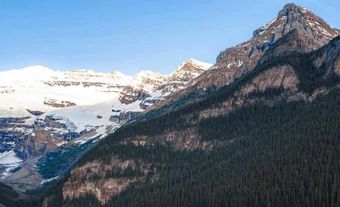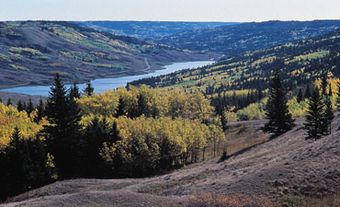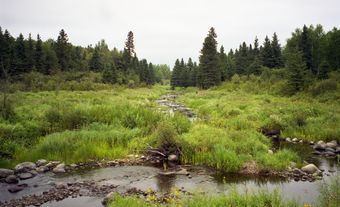Background
A convention concerning the protection of the world's cultural and natural heritage was launched by United Nations Educational Scientific and Cultural Organization (UNESCO) in 1972. It aimed to recognize and protect sites around the world with universal natural or cultural significance. Designations require the co-operation of participating countries. Nearly 200 states have signed the convention, agreeing to protect designated properties within their boundaries and to contribute to the World Heritage Fund, which was established to help preserve endangered sites. World Heritage sites are selected by a committee according to established criteria.
Canadian United Nations World Heritage Sites
| Site | Year Designated | Location | Significance of designation |
| Nahanni National Park | 1978 | Northwest Territories | Includes 4,700 km2 of undisturbed natural area with remarkable geological features. |
| L’Anse aux Meadows | 1978 | Newfoundland and Labrador | This Viking settlement is considered evidence of the first Europeans in Canada. |
| Kluane / Wrangell-St. Elias / Glacier Bay / Tatshenshini-Alsek | 1979 | Yukon Territory, British Columbia | The largest non-polar ice field in the world. |
| Dinosaur Provincial Park | 1979 | Alberta | Park holds some of the most important dinosaur fossils dating from 75–77 million years ago. |
| Head-Smashed-In Buffalo Jump | 1981 | Alberta | Site is one of the oldest and best-preserved communal hunting grounds. |
| SGang Gwaay | 1981 | British Columbia | Includes remains of Haida civilization illustrating past culture and way of life. |
| Wood Buffalo National Park | 1983 | Northwest Territories, Alberta | The park is one of the largest undisturbed grass meadows left in North America. |
| Canadian Rocky Mountain Parks
(includes Banff, Jasper, Yoho and Kootenay) |
1984 | British Columbia, Alberta | The area is a combination of four national parks and three provincial parks which illustrate glacial geological processes. |
| Historic District of Old Quebec | 1985 | Quebec | The district is the most complete illustration of a fortified colonial town north of Mexico. |
| Gros Morne National Park | 1987 | Newfoundland and Labrador | The landscape provides one of the world’s greatest examples of plate tectonics. |
| Waterton-Glacier International Peace Park | 1995 | Alberta, Montana | The landscape exemplifies diversity of scenery, wildlife, flora and topographic relief. |
| Old Town Lunenburg | 1995 | Nova Scotia | Town is the best-preserved example of planned British colonial settlement in North America. |
| Miguasha National Park | 1999 | Quebec | This fossil site is considered to be the world’s most outstanding example of the Devonian period. |
| Rideau Canal | 2007 | Ontario | The canal is the best-preserved North American slackwater canal. |
| Joggins Fossil Cliffs | 2008 | Nova Scotia | These exposed rocks provide the finest and most complete fossil record of terrestrial life in Carboniferous period. |
| Landscape of Grand Pré | 2012 | Nova Scotia | The marshland and archaeological remains serve as a remarkable example of traditional Acadian settlement. |
| Red Bay Basque Whaling Station | 2013 | Newfoundland and Labrador | The station is the most extensive and best-preserved example of traditional 16th century Basques whale hunting techniques. |
| 2016 | Newfoundland and Labrador | These cliffs on the east coast of Newfoundland contain some of the oldest known fossils on Earth. The fossils date back to the Ediacaran Period (630-542 million years ago) and chronicle the appearance of biologically complex organisms. | |
| Pimachiowin Aki | 2018 | Manitoba, Ontario | Pimachiowin Aki is part of the traditional lands of the Anishinaabeg and encompasses nearly 30,000 km2 of boreal forest. The First Nation communities who live there continue to use the forest and waterways as their ancestors did, and the area is testament to the Anishinaabeg tradition of honouring and respecting the land. |
| Áísínai’pi (Writing-on-Stone) | 2019 | Alberta | This area, a part of Writing-on-Stone Provincial Park, features thousands of rock art images, representing the largest concentration of Indigenous rock art in the North American plains. |
| Ile d' Anticosti | 2023 | Quebec | This Island contains the most complete and well-preserved fossil record of the first mass extinction of animals, which took place from 447 to 437 million years ago. |
| Tr’ondëk-Klondike | 2023 | Yukon | This area rests within the homeland of the Tr’ondëk Hwëch’in First Nation. It holds historical records showing how Indigenous people adapted to the unprecedented changes brought about by the Klondike Gold Rush from 1897-1899. This site has eight components. |

 Share on Facebook
Share on Facebook Share on X
Share on X Share by Email
Share by Email Share on Google Classroom
Share on Google Classroom



